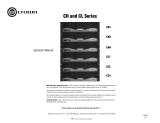
16
EN
TD-000077-00-K
2- and 4-Channel Distributed 70V Line Models
CX204V CX302V CX602V CX1202V
Output Power (Watts)
20 - 20k Hz, 0.03% THD, 70V/Ch. 200 200 400 800
20 - 20k Hz, 0.03% THD, 8 Ohms/Ch. 550 700
20 - 20k Hz, 0.05% THD, 4 Ohms/Ch. 1100
1k Hz, 0.05% THD (EIA), 70V/Ch. 220 250 440 1000
1k Hz, 0.1% THD (EIA), 70V/Ch. 300 600 1200
1k Hz, 1.0% THD (EIA), 70V/Ch. 300
Bridge Mono, 140V, 20 - 20k Hz, 0.1% THD 400 400 800 850
Bridge Mono, 140V, 1k Hz, 0.1% THD 440 600 1200 2400
Bridge Mono, 1k Hz, 0.1% THD, 16 Ohms 1200 1400
Bridge Mono, 1k Hz, 0.1% THD, 8 Ohms 2300
Distortion, SMPTE-IM <0.02%, all models
Frequency Response 20 - 20k Hz, ±0.2dB at 10dB below rated output power, all models (-3dB points: 8 Hz and 100 kHz)
Signal To Noise, Unweighted, 20 - 20K Hz -106 dB. all models
Voltage Gain 56.6x (35dB) all models
Input Sensitivity, Vrms 1.26V (+4.2dBu) for rated power at 70.7V
Output Circuit Type AB AB AB H
Input Impedance 6k ohms unbalanced, 12k ohms balanced, all models
Dynamic Headroom 2 dB at 4 Ohms, all models
Damping Factor >500 at 8 Ohms, all models
Amplifier Protection Short circuit, open circuit, thermal, ultrasonic and RF protection. Stable into reactive or mismatched loads
Cooling Continuously variable speed fan; back-to-front air flow through heat sink tunnel
Controls
Front
Back
AC POWER switch, gain controls (1 control per channel, 21 detents)
10-position DIP switch with Clip Limiter (1 per Ch.), LF Filter on/off (1 per Ch.) LF filter select: 33 or 50 Hz (1 per Ch.), Stereo/
Parallel/Bridge mode selection switches
Led Indicators POWER (green, 1 each), SIGNAL, -10dB, -20dB (green, 1 each per Ch.), CLIP (red, 1 each per channel), BRDG and PAR
(yellow, 1 each)
Connectors
Input
Output
Other
3-pin terminal blocks ("euro" or "Phoenix" type)and XLRs (pin 2 positive)
barrier strip connectors with protective shroud
QSC DataPort connector (supports full “V1”feature set)
Load Protection Turn-on/turnoff muting, AC coupling (DC fault blocking), Clip limiting.
Power Requirements Refer to rear panel serial number label. Configured at factory for 100, 120 or 220-240 VAC, 50- 60 Hz.
Dimensions 19.0" (48.3 cm) W, 3.5" (8.9 cm) H, 14" (35.6 cm) D (from front mounting rails, including rear support ears)
Weight 21 pounds (9.5 kg) net; 27 pounds (12.3 kg) shipping
Specifications are subject to change without notice.

















